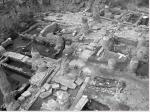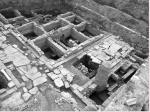Summary (English)
EXPLORATIONS IN PHILIPPOPOLIS (Zheni Tankova – RAM.Plovdiv@gmail.com) Two decumani and a cardo with water-conduits and drains, five insulae with 10 buildings comprising 42 rooms and a fortification wall, 3 m wide and dated after the middle of the 6th century AD were explored over an area of 2300 sq. m. Six construction periods were documented in occupation layers, 3.60 m thick. The first construction period dates to the end of the 3rd – 2nd centuries BC. The finds include coins, jewelry, fragmentary dolia and sherds. The rooms of the later periods partly coincided with the layout of the rooms from the earliest period. The second construction period dates to the 1st century BC – 1st century AD. The finds include fragmentary amphorae, jugs, etc. The third construction period dates to the 2nd – 3rd centuries AD. A temple, 30 m long, was explored in insula No. 2. The temple had one central and two side rooms. The building was burned. Fragmentary decorative stucco, three-color wall plaster, marble veneer panels and architectural decoration were found on the hardwood floor, under the layer of burned debris. The finds include two marble heads of Zeus and Mithra, fragmentary votive reliefs of the Thracian Horseman, Zeus, Hera, Mithra and Asclepius, handles of ceramic paterae. A bothros, containing hundreds terracotta figurines of deities of the Greco-Roman and the Eastern pantheon and terracotta lamps, was discovered. The fourth construction period dates to the end of the 3rd – first half of the 5th centuries AD. A room with floor of bricks and a cross-like piscina was discovered. Its walls were covered with red plaster. Another room had an entrance towards the cardo and polychrome wall paintings, showing geometric figures and a plinth imitating marble veneer and two bases of columns. Fragmentary wall paintings with images of human eyes were found, too. There was a kline, 3.50 m long and 70 cm wide, adjoined to the western wall of the room. The floor was paved with stone slabs. The fifth construction period dates to the 5th – 6th centuries AD and was preceded by a fire. The sixth construction period dates to the Middle Ages.
- Zheni Tankova - Archaeological Museum – Plovdiv
Director
Team
Research Body
- Archaeological Museum – Plovdiv






![Download [PDF]](/excavation/skins/fasti/images/results/download_sml.png)
